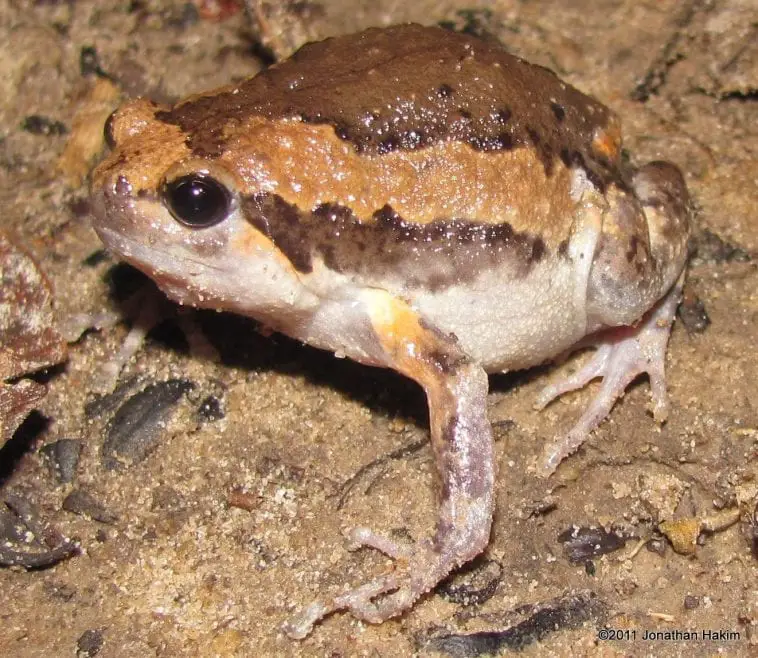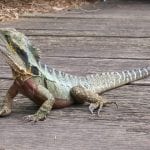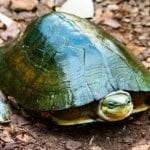Scientific Facts
| Common Name | Asian Painted Bullfrog, Chubby Frog, Asian Painted Frog, Rice Frog, Bubble Frog |
| Scientific Name | Kaloula Pulchra |
| Life Span | 10 years or more |
| Length | 2 to 3 inches |
| Clutch Size | |
| Habitat | Forest floors, rice fields |
| Country of Origin | Southeast Asia |
Physical Description
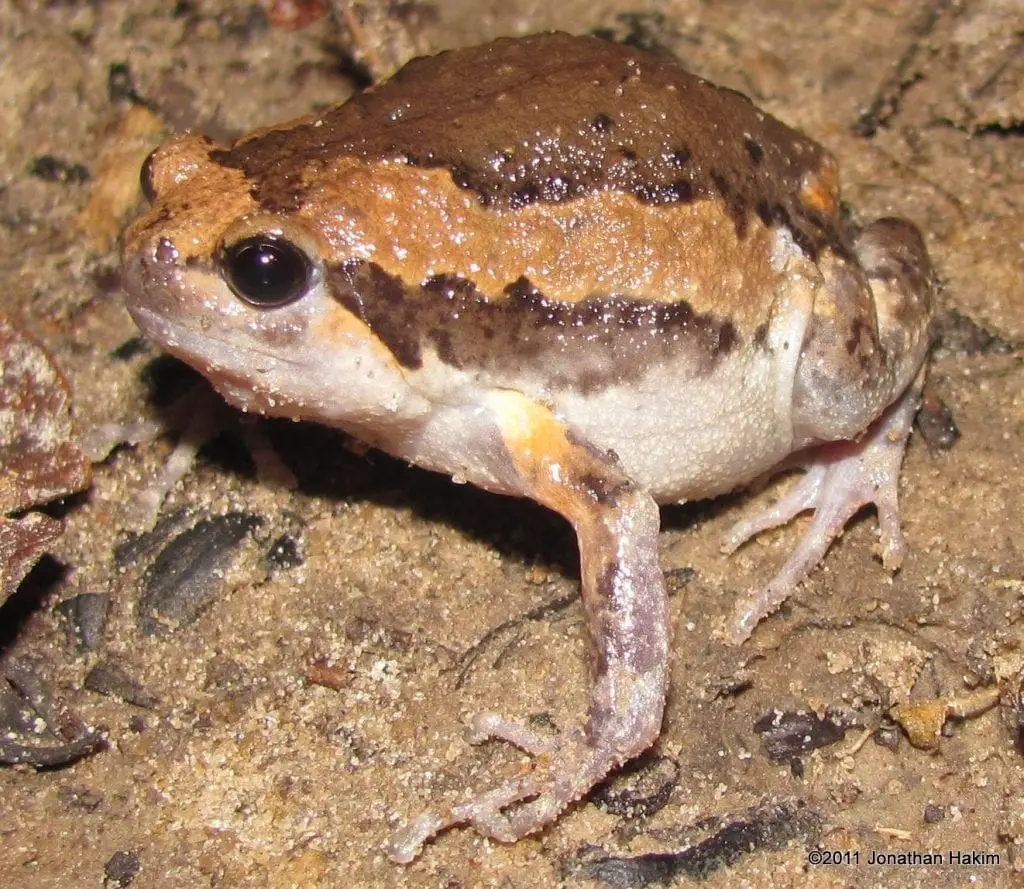
As suggested by one of its common names, chubby frogs grow to about 2 to 3 inches, with a round, stocky, and robust stature. They also have a short and rounded shout, paired with short limbs that prove ideal when it comes to jumping long distances and crawling into crevices.
In terms of color, the Asian Painted frog features a mottled-brown background, with some mark of wide and black-bordered bands of pale orange or creamy yellow patterns. They are underparts feature a creamy, and dirty shade of gray, while their metatarsal tubercle develops into a hard and spadelike projection which allows the frogs to burrow backward into their earth in an amazing speed.
With a round shape and a unique microhylid body structure, these frogs are patterned attractively with two cream-colored lateral stripes running down to their dorsum. This coloration extends further to their face and head, contrasting with a darker brown on the remaining parts of the flanks and dorsum just below the light stripes. The ventral part is typically uniform white to gray. Males, however, have a darkened vocal sac after calling.
Habitat and Distribution
It is quite common to see Asian Painted Frogs throughout various regions in Southeast Asia. They are usually adaptable, as seen in the way they can live around humans, in gardens and courtyards, as well as in agricultural areas and forests, and forest edges.
At daytime, however, they are not active, usually hiding in burrows or shelters. At nighttime, they usually move around, even climbing taller vegetation and trees. When nervous or threatened, frogs fill with air, even secreting a sticky white and noxious substance.
During rainy days, Asian Painted frogs usually gather as a group near pools of water. On normal days, these frogs are typically found among the debris, under rocks, and among the grasses. They can live almost anywhere in the wild, provided that the habitat can provide them with moisture and food. They also seek sheltered places where they can easily squeeze themselves in to find protection.
The populations of these frogs have a wide range of distribution in Southeast Asia, including Indonesia, Philippines, Laos, Malaysia, Singapore, India, Sri Lanka, Taiwan, Myanmar, Vietnam, and Thailand. For this reason, they cannot be categorized as an endangered species.
Recognized Subspecies
When it comes to localities, there are actually three recognized subspecies of Kaloula Pulchra. This includes the nominate K.p. pulchra, the K.p macrocephala (the ones from the town of Tonkin in the northern part of Vietnam), and K.p. hainana (from the Hainan Island in the South China Sea). Regarding the real taxonomic stature of each of these subspecies, a discussion is still ongoing, whether they need to be treated as their own species, or they continue to be regarded as subspecies.
Breeding in the Wild
Among the most interesting things about the Asian Painted Bullfrog is its rapid development and breeding. Unfortunately, this is observed rarely in captivity. Since these frogs are readily available as a species, breeding them will not cause initial outlay. This means that breeding them for selling may not really make you earn a lot, but the entire experience is enjoyable already, as it can teach you techniques and cycle, which can be adapted in breeding other microhylid species later on.
It is a common thing to observe these frogs breeding explosively after pours of heavy rains in India. This usually happens between April and May. In other areas of their range, breeding can be year-round. They usually use temporary rain pools, as well as flooded ditches for breeding, leading them to evolve in a very rapid way, in as short as two weeks.
This fast growth rate ensures that most of the offspring are out of the water even before the pools start to dry up. With the introduction of civilization, however, these frogs have also adapted to the use of animal water troughs and garden features, providing a better permanent source of water, while resulting in a higher survival rate.
If you want to reproduce Asian Painted Bullfrogs in captivity, it is important to mimic the environmental conditions that they are familiar with in the wild. Of course, this still depends on the origin of the specimens that you want to breed, which means that the cycle may vary slightly in terms of temperature. For example, species from Vietnam seem to need more cooling compared with species form Malaysian or Indonesian origin.
Breeding in Captivity
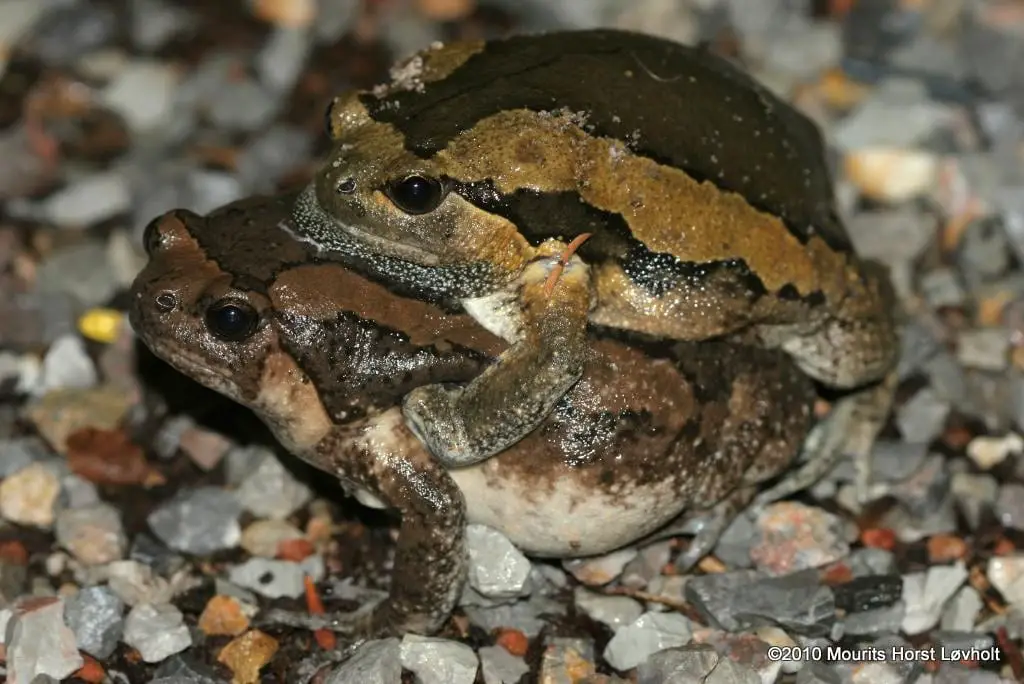
In order to experience the best chance of success, it is recommended to have a breeding stock of 6 to 12 frogs. Start with a male to female ratio of 2:1 or 3:2. This will stir up competition among males, thus stimulating their breeding activity. The calling of the male will also help in stimulating the female frogs.
Sexing the adult frogs is quite straightforward. Male frogs have a dark, black, or dusky gray throat, even when they are out of the breeding condition. The female frogs’ throat, on the other hand, retains a pale color on the ventral surface.
After the group has finally settled in their enclosure, and they have already reached a good size and weight for breeding, their cycle can start. Usually, it is the easiest to record the time and cycle around the late autumn or early springs, as the temperatures are low enough to complete the cycle without the need to use artificial cooling.
The first part of the cycle is the introduction of a cooling period, which helps in inducing the chubby frogs to go into a brumation state. These frogs do not hibernate similar to other temperate species, and they also do not aestivate like other frogs, such as those from the Savannah regions. Still, they are ready to merge and eat on a wet and warm evening.
In order to help in stimulating the brumation phase, the humidity level needs to be dropped to the range between 50 to 60%. Allow the surface of the selected substrate to dry slightly. This will further encourage your frogs to burrow down as you start lowering the temperature.
Also, the amount of food that you feed your frogs also needs to be decreased at this point, though they do not need to go through starvation right before or during brumation. You can stop feeding your frogs crickets. Rather, you may want to introduce a woodlice colony, so food is available for the frogs if they want to enjoy it.
In a period of 2 or 3 weeks, the temperature needs to be lowered gradually. For frogs imported from Malaysia and Indonesia, it has been observed that a low temperature of 60 degrees is enough. For those from Vietnam, on the other hand, lowering the temperature further to around 54 degrees is observed to be effective.
As the temperature reaches the 68-degree mark, you can start removing the décor inside the terrarium, bringing in more substrate, and allowing the surface of the substrate to dry even further. The moment that the first inch or more is almost dry, the frogs will be stopped from burrowing deeper and preserve moisture. This will then further insulate them from the cold temperatures that they will be exposed to.
If you prepared to light for your enclosure, it is recommended to decrease their operating hours gradually, from 12 to about 8 to 10 hours per day. Cycles of light do not seem to be important during breeding. In fact, success has been observed in breeding these frogs even without using any artificial lighting. Still, every single thing that you do, including the installation of lighting, may enhance some breeding triggers, thus increasing your chances ultimately for successful mating.
These new levels of temperature and lighting should be maintained for about 4 to 6 weeks. If you notice activity in the evenings, you may still offer a small amount of food. However, during the process, any disturbance, including feeding, should be kept to a minimum.
Frogs may be uncovered carefully from time to time in order to check and make sure that they are still in good health condition. Be alert in monitoring for any sign of discoloration, desiccation, or a sudden weight loss. If you notice some signs of ill health, remove the affected frog and place it in a quarantine tank, gradually bringing it back to the normal maintenance levels.
Towards the end of 4 to 6 weeks, increase the temperature and humidity gradually, giving back the normal levels in a period of two weeks. These frogs may not start to become active again until the levels of humidity are further raised to about 85 to 90%, while the normal moisture levels in the substrate should also be reinstated.
Once you notice that your frogs are already active and awake, it is now time to introduce them to the first phase of the two rain chamber designs that you will introduce for breeding. The basis for your rain chamber needs to be a deep, large aquarium. The same aquarium used for breeding can also be used. However, when you need to start rearing tadpoles, you may want to get a large enclosure. A minimum enclosure of 36 x 18 x 18 in size is recommended.
Rain Chamber System
The first rain chamber system uses a circulatory rain system. Water is flushed through the system, mimicking the effect of heavy monsoon rains. A number of ways can be done to do this. The preferred option is to make a drain and an external sump. This is where water is filtered and then pumped back to the rain bar. There are a number of advantages of using this system, which includes maintaining the quality of water. A disadvantage, however, is that some experience may be needed in order to complete the setup successfully.
An alternative option is to use a false bottom and reservoirs in the aquarium base. A plastic egg-crate grid can be used, supported by PVC pipe columns using a filter and a pump system that is mounted beneath. The pump size highly depends on the size of the enclosure, though the reservoir needs to be just slightly deeper than your pump, which is about 2 to 3 inches.
In order to create this rain chamber, install a small filter for the aquarium, along with the tubing and pump for the rain system. Place the plastic grid on top, ensuring a tight fit in the aquarium. The setup should also be supported well in order to carry the weight of the frogs and substrate. After, you can lay a barrier that allows water to freely drain, but prevent the substrate from washing away. The recommended and effective option for this is using some sheets of weed-suppressant membrane, fine-filter foam, or other close-weave cloth.
This can be cut a bit larger than needed, lapping them up against the glass to create a seal to avoid the substrate from going through the edges. The substrate can be introduced next, in a way that is similar to using the same free-draining mix. A simple décor can still be introduced in order to provide the needed shelter from the rain.
This rain system should operate for at least several hours in the early morning and early in the evening. After a couple of days, this schedule can be increased to operate all night, running occasionally for a 24 hour period. With this system, you can start noticing an increase in the activity of your frogs. The males will be observed to call in the chorus, while the female frogs will start fattening with eggs.
When these significant changes are observed, feeding needs to be increased as well. Each day, feed your frogs as much as they can to make sure that they are fattened up and all ready for breeding. After 2 to 3 weeks in this chamber, your frogs are almost ready for breeding. Breeding using this system may need experience, but if breeding is your game, all the effort is worth it. You still have the option, though, to breed your frogs using the natural way.
Housing
Asian painted frogs do not usually need a huge space to thrive well in captivity. A 10 gallon, a standard aquarium which measures 20 x 10 x10 inches, is big enough to house one frog. A screen cover that is tight-fitting is also essential to avoid escapes. Keep in mind that these frogs are good climbers. When provided with enough arboreal space in a bigger enclosure, they might attempt to escape, especially at night.
Furnish your enclosure with hiding spots. This may come in the form of cork bark, artificial plants, or driftwood. You may use live plants as well, though there is a tendency for the plants to be uprooted when the frogs burrow. In order to prevent this from happening, it may be beneficial to keep the plants right in their pots instead of directly planting them in the substrate.
Substrate
A good substrate for your frog’s enclosure is one that can hold moisture. This type of substrate allows your pet to burrow. Among the best options for the substrate are coconut husk fiber as well as other safe soil blends. Make sure to avoid using soils that contain either perlite or vermiculite.
Other options that are possible include leaf litter or cypress mulch, foam rubber, moist paper towers, or sphagnum moss. Sand, gravel, or small bark chippings are substrates that need to be avoided since they can be swallowed easily, which may, in turn, cause health issues.
Food and Diet
Asian Painted Frogs are known for their huge appetites. They usually accept most feeder insects, including earthworms, crickets, wax worms, silkworms, and mealworms, all of which are usually available commercially. The majority of their diet is composed of crickets, along with other food substitutes in every few feedings.
It is recommended to feed your frogs 3 to 6 kinds of food every 2 or 3 days, especially for adult frogs. The younger frogs need to be fed more frequently with vitamins and mineral supplements. This will help coat the food that is fed to adult frogs every 2 to 4 feedings. Juveniles, on the other hand, need to have their food supplemented in every meal.
Water
These frogs love soaking in water. With this in mind, it is best to provide a water dish that is big enough for your frog to soak in. Replace the water every day, or when it already appears dirty. When using tap water, it is best to use a tap water conditioner, as it works in removing chlorine, chloramines, as well as other heavy metals.
As an alternative, reverse osmosis (RO) water may be used with the addition of aquarium products that are designed to add helpful minerals and restore pure water sources.
Temperature
Asian Painted frogs tolerate a wide range of temperatures. At daytime, the temperature can range from 68 degrees to 78 degrees Fahrenheit. At nighttime, the temperature also goes down. Occasional cool nights or warm days usually do not pose a problem for healthy bullfrogs.
The temperature inside the enclosure may be controlled using a thermostatic heat mat that is set between 75 to 80 degrees Fahrenheit in the daytime. Because of the deep depth of the substrate, heat mats are placed ideally on the back or side of the enclosure, insulated using polystyrene tiles that work in reflecting heat back into the terrarium. When using heat mats, it is best to avoid using foil or foil-lined polystyrene in insulating your heat mats, because this may result in hot spots, burned-out heaters, and cracks in the glass tank.
Humidity
The humidity level inside the frog’s cage may play a huge role in the behavior and activity of Asian painted frogs in captivity. In the wild, a significant increase in moisture and humidity initiates breeding. Often, male frogs will start calling when the same occurs in the terrarium. It is also a good thing to mist part of the cage with water several times a week, even every day. This is found to be effective in maintaining moisture, and thus, stimulate their activity.
Humidity should be kept around 70% percent in the region. This can be achieved through the release of moisture coming from the damp substrate. This can be controlled and replenished by regular misting. When using an enclosure with a screen top, it may be beneficial to restrict some ventilation. This can be done by placing clear acrylic or glass over part of the mesh in order to retain humidity.
Lighting
Lighting is not really necessary unless you are using live plants inside the enclosure. However, lighting can still define a daytime/nighttime cycle, which could prove to be beneficial for breeding and in adding to the viewing pleasure.
If you opt to light your enclosure, a standard freshwater aquarium tube, or a daylight compact lamp can be used in illuminating the enclosure for about 12 hours a day.
Conservation Status and Threats
Even though this species is collected both for food and for the pet trade, it has adapted even to the urban environment, while continuing to thrive in the wild. At times, they end up in shipping vessels and in other unlikely places. To some, their uncontrollable population makes them pests.
How to Care for Asian Painted Bullfrogs
These bullfrogs are hardy and undemanding, requiring little space for their housing. Placing a free-draining substrate and moisture content that is easily controlled is very important, particularly in the breeding season. Since these frogs love burrowing, the substrate that you choose needs to be somewhat deep and damp, yet not sodden.
You may want to arrange flat rocks, cork bark, or broken terracotta pots on the surface in order to create hides and crevices for your frogs to burrow under or squeeze in. Plants, such as ferns and pothos, may also be added as additional aesthetics.
Make sure that the housing has a water bowl all the time. This bowl should be a big, heavy, and shallow ceramic bowl, similar to a dog bowl, in order not to be disturbed by any burrowing activity. Similar to all amphibians, the water needs to be dechlorinated first. This can either be done by treating it using an aquarium water conditioner, or by simply allowing it to stand for about 24 hours. It is recommended to refresh the water supply every day, in order to avoid potential build-up of dangerous waste products.
Where to Get an Asian Painted Bullfrog
Asian Painted Bullfrogs are usually available for sale through dealers and pet stores. Captive breeding of this species is rare. This means that most chubby frogs for sale are wild-caught. Because of this reason, it is recommended to examine the frogs carefully before buying one to make sure that they are healthy and in good condition.
Healthy Asian Painted Bullfrogs naturally respond to being disturbed by puffing up, hopping away, or inflating themselves with air. This is done in order to avoid lethargic ones, or those with marks such as rubs or small abrasions because of transit, including frogs which show redness signs on their skin.
Interesting Facts
During the mating season, male frogs usually float in the water, while making loud “honks” in order to attract the females. This call is cow-like, produced by sucking in air. Because of their rotund structure, they look like floating beach balls with attached legs. The eggs that are laid after mating are usually small, even forming a film on the water surface.
FAQs
How I can choose the right chubby frog?
For one, as suggested by the name, choose a frog that is “chubby” and healthy. The body should be round and full. You can notice that the frog is underweight if you see that the bones are sticking out.
How often should I feed my chubby frog?
You may feed your frogs three to six items of food every two or three days. This is recommended for adult frogs. Juveniles, on the other, need to be fed more frequently. High-quality vitamins, along with supplements, also should be used to coat the food fed to adult frogs every 2 or 4 feedings. Supplements should have their food supplemented in every meal.
What do chubby frogs eat?
Note that chubby frogs are huge eaters. Among the food items in their diet include crickets, flies, mealworms, moths, earthworms, nightcrawlers, butter worms, wax worms, and small grasshoppers.
How long do chubby frogs live?
In captivity, provided that they are well-fed and kept clean, they have the potential to live and thrive for 10 years or more.

